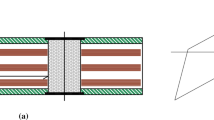Abstract
Isolation is an effective method of reducing effects of seismic events on building structures. Steel-reinforced elastomeric isolator (SREI) is one kind of isolation system which is used extensively, but there are some problems associated with its use, such as cost and weight. Fiber-reinforced elastomeric isolator (FREI) has been developed in an attempt to solve the problems of high cost and heavy weight for SREI. In this study, mechanical properties for the SREI and the FREI are investigated. Systematic dynamic response analyses are performed for three different models such as a fixed based, an SREI based and an FREI based low-story building structures. Two-dimensional and three-dimensional dynamic response analysis results for each model are compared in terms of displacement, drift, acceleration and shear force in this study. In the two-dimensional dynamic response analysis, the SREI and the FREI based structures are proven to be the more effective isolation systems against seismic events by comparing with the fixed based one. As a result, the FREI has shown better isolation performances than that of the SREI. Furthermore, to extract the characteristics of the FREI on building structure resisting the seismic effects, two models of three-dimensional framed structure with fixed bases and FREI isolated bases are built, respectively. After the dynamic response analysis of these two structures subjected to bi-directional ground motions, the analyzed results are compared with each other. It is shown that the FREI could effectively absorb the seismic energy, and decreases the destructive effects acting on a building structure due to ground horizontal motions that could occur in an earthquake.
Similar content being viewed by others
References
A. B. Othman, Property profile of a laminated rubber bearing, Polymer Testing, 20(2) (2001) 159–166.
H. C. Tsai and S. J. Hsueh, Mechanical properties of isolation bearings identified by a viscoelastic model, International Journal of Solids and Structures, 38(1) (2001) 53–74.
M. Iizuka, A macroscopic model for predicting large-deformation behaviors of laminated rubber bearing, Engineering Structures, 22(4) (2000) 323–334.
W. J. Chung, C. B. Yun, H. S. Kim and J. W. Seo, Shaking table and pseudo-dynamic tests for the evaluation of the seismic performance of baseisolated structures, Engineering Structures, 21(4) (1999) 365–379.
K. Masaki, N. Kazuyo, S. Masaki and T. Yasuo, A study on response during large deformation in a seismic isolation system of nuclear island buildings, JSME International Series C, 33(3) (1990) 404–411.
J. M. Kelly, Analysis of fiber-reinforced elastomeric isolator, Journal of Seismic Earthquake Engineering, 2(1) (1999) 19–34.
B. Y. Moon, G. J. Kang, B. S. Kang and J. M. Kelly, Design and manufacturing of fiber reinforced elastomeric isolator for seismic isolation, Journal of Materials Processing Technology, 130–131 (2002) 145–150.
B. S. Kang, G. J. Kang and B. Y. Moon, Hole and lead plug effect on fiber reinforced elastomeric isolator for seismic isolation, Journal of Materials Processing Technology, 140 (2003) 592–597.
G. J. Kand and B. S. Kang, Dynamic analysis of fiber-reinforced elastomeric isolation structures, Journal of Mechanical Science and Technology, 23 (2009) 1131–1141.
Author information
Authors and Affiliations
Corresponding author
Additional information
This paper was recommended for publication in revised form by Associate Editor Seockhyun Kim
Beom-Soo Kang received his B.S. in Mechanical Engineering from Pusan National University in 1981 and his M.S. in Aerospace Engineering from KAIST in 1983, Korea, respectively. He then received his Ph.D. from the University of California at Berkeley, USA, in 1990. Dr. Kang is currently a Professor at the Department of Aerospace Engineering at Pusan National University in Busan, Korea. His research interests include seismic isolation, materials processing, FEM and flexible forming technology.
Tae-Wan Ku received his B.S., M.S. and Ph.D. in Aerospace Engineering from Pusan National University, Korea, in 1997, 1999 and 2003, respectively. Dr. Ku is currently a research professor at the Department of Aerospace Engineering at Pusan National University in Busan, Korea. His research interests include multi-stage deep drawing, flexible forming technology, and forming limit surface theory.
Rights and permissions
About this article
Cite this article
Kang, BS., Li, L. & Ku, TW. Dynamic response characteristics of seismic isolation systems for building structures. J Mech Sci Technol 23, 2179–2192 (2009). https://doi.org/10.1007/s12206-009-0437-x
Received:
Revised:
Accepted:
Published:
Issue Date:
DOI: https://doi.org/10.1007/s12206-009-0437-x




